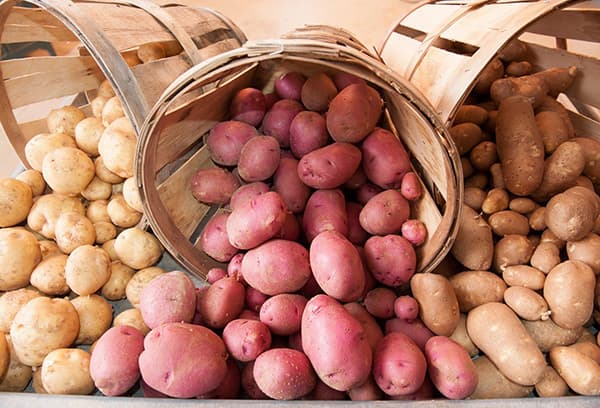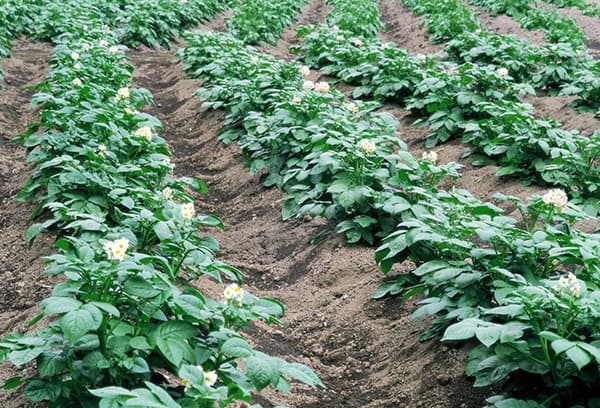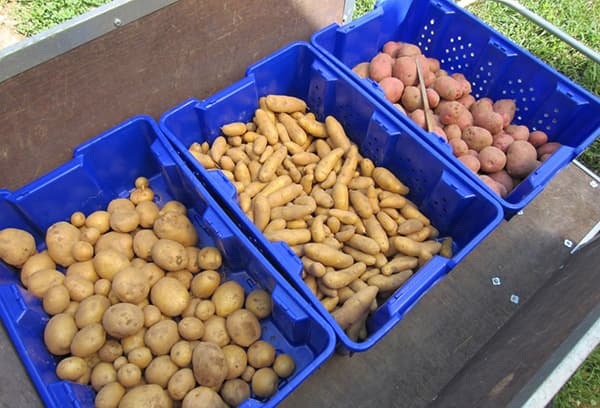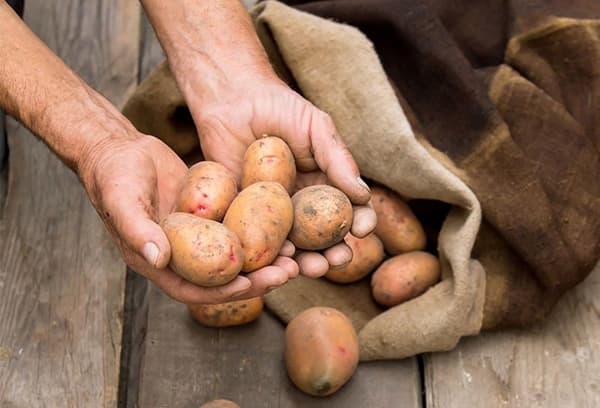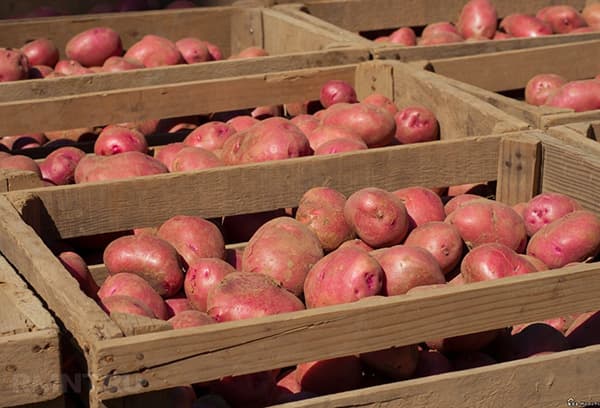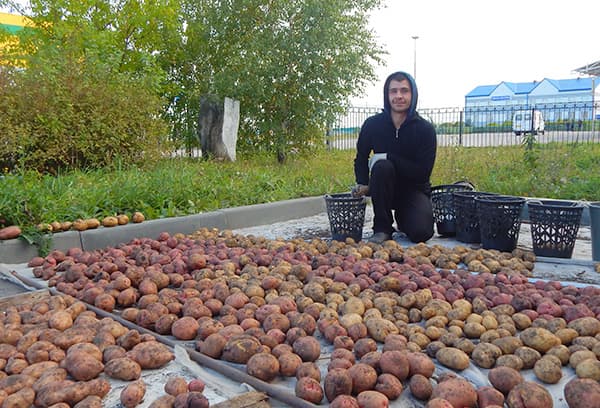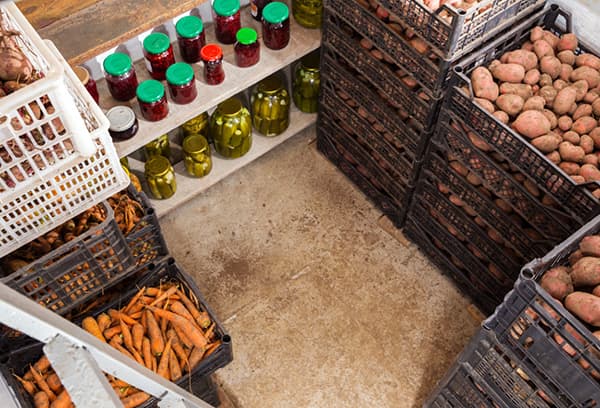How to keep potatoes in the cellar until the new harvest?
Content:
With the onset of autumn, many owners begin to harvest potatoes for the winter. It is best to store potatoes in the cellar, but a basement, an unheated garage, and even a refrigerator box under the window can be adapted for storage. The main thing is to choose a still variety, properly prepare the room and vegetables for laying, and maintain optimal storage conditions throughout the winter.
What varieties are suitable for storage?
When laying potatoes for storage, it is important to remember that only medium-late and late-ripening varieties lie until spring.
Of course, you can fall asleep vegetables with early ripening, for example, "Aurora", "Rocco", "Pyrol", "Hostess" and others. These varieties have excellent taste, they just lie for a short time, maximum until the end of November, and then they begin to sprout and deteriorate.
For long-term storage, it is better to take varieties of medium and late ripening, for example:
- Gatchinsky
- "Gull",
- Gingerbread Man
- "Slav",
- Scarlet and others.
Before buying potatoes, it is very useful to consult with local vegetable growers who have been cultivating this root crop for more than one year and know for sure which variety will be well stored until the next harvest, and which is better to use as directed.
Growing conditions affect keeping quality
The pot life of potato tubers directly depends on weather conditions, soil composition, fertilizers and other nuances of cultivation.
- Vegetables grown in cold rainy weather will be twice as bad as the crop harvested after a sunny, dry summer.
- To better store potatoes, they should be planted on dry soils with a high sand content. A crop grown on loam is unlikely to last until spring.
- The quality of potatoes is affected by fertilizers that fed plants during the growing season. Excess nitrogen contributes to an increase in sugar content - such a product is susceptible to various diseases, rots quickly and is not suitable for laying in storage.
- Blight damage worsens the quality of potato tubers.
To make the potato peel coarser and the tubers more resistant to damage, green tops must be mowed a week before the harvest.
Preparing the tubers for the bookmark
Before you lower the potatoes into the cellar or put in another place prepared for this for long storage, you must properly prepare the tubers. Preparation consists of several steps.
Tubers sorting
First of all, you need to make sure that all products prepared for long-term storage are of good quality. Even a few rotten tubers that have fallen into the cellar can ruin the entire crop.
Potatoes grown in their area should be divided into seed and the one that goes to the “for food” tab. Tubers set aside for planting the next year are kept in the sun for several days to increase resistance to decay, and then sent to storage.
Potatoes left for food are carefully inspected, choosing whole intact tubers without sprouts, and sorted into separate heaps according to the following criteria:
- medium-sized vegetables, clean and whole, suitable for long-term storage;
- the largest tubers lie well for 1-2 months, then begin to dry - they must be eaten before the New Year;
- first of all, you need to use small, cut or eaten by pests copies - such potatoes will not be stored.
Sorting is the most important part of laying potatoes in the cellar, it should be taken with all responsibility, otherwise you may be left without supplies.
Cleaning
The widespread belief that potatoes should never be washed before laying in the cellar is unfounded. Whether the potato was washed or not does not matter, the main thing is to dry it well.
Washed potatoes do not contaminate the cellar, it is convenient to work with it in the kitchen, in addition, all damage, usually hidden under a layer of dirt, is clearly visible before laying. Of course, such work is difficult to carry out when harvesting large volumes, since it takes time, a lot of water and certain conditions for drying. Therefore, experts advise washing potatoes only if they were harvested after rain and the tubers are very dirty with dirt. In other situations, it is enough to clean the dry vegetables from the ground by rubbing them with a cloth or glove.
Drying
Potatoes dug or bought at the market must be thoroughly dried before being put into the cellar. To do this, wait for the sunny weather, scatter the vegetables in the yard, on the site near the cellar or on the balcony and ventilate for 10-12 hours. At night, it is better to collect vegetables and bring them into the room, since morning dew will reduce all efforts to nothing.
It would be nice to hold the tubers in the sun for 2-3 hours. Ultraviolet rays will destroy microbes and pathogens.
Cellar preparation
The most suitable place for long-term storage of potatoes and other vegetables is, of course, the cellar. It can be arranged in a separate room, underfloor, basement or in an unheated garage.
The cellar is prepared a few days before laying supplies. The work consists of the following steps.
- Check the humidity in the room. If the cellar is damp, it must be ventilated. You may need to build an additional hood or vent. In any case, the cellar should be dry.
- It is necessary to disinfect and dry the container for storing potatoes: wooden boxes, shelves, barrels and other devices. To do this, they are treated 2-3 times with a strong solution of potassium permanganate, and then dried in the sun.
- It will be useful to disinfect the walls of the room using whitewash, for the preparation of which they take 2 kg of lime, 1 kg of copper sulfate, 150 g of salt, mix and dissolve in 10 l of water. The resulting solution is treated twice with an interval of 7 days.
The more carefully prepared the cellar, the better the potato will be stored.
When laying vegetables, you must remember that potatoes can not be kept next to cabbage, onions or carrots. But the neighborhood with red beets favorably affects the safety of tubers. Beetroot draws moisture, leaving potatoes dry.
To store vegetables use nets, bags, special wooden boxes and compartments. The main thing is to ensure free air circulation, so that the product does not cake, does not prel and does not rot.
Winter storage conditions
In winter, potato tubers are in a state of deep dormancy, which usually lasts until early March. During this period, it is necessary to maintain optimal storage conditions: illumination, temperature, humidity.
- Illumination
One of the most important conditions for storing potatoes is darkness. In the light, in the tubers, the amount of solanine increases. This plant poison is found in all nightshade and in small doses does not affect human health. However, after three months of storage of tubers in a bright room, its content exceeds acceptable standards. Therefore, it should be dark in the cellar or garage, and it is better to cover the vegetables with burlap, plywood or a piece of dark cloth.
- Temperature
Many people wonder at what temperature potatoes can be stored for as long as possible. If the cellar is too warm, harmful microorganisms that cause rotting of the tubers are activated, and the eyes begin to sprout. In a cold storage, the potatoes simply freeze.After all, even at 0 ° C the starch contained in this product turns into sugar - and the vegetable acquires an unusual sweet taste. And at lower temperatures, the fruits turn black and become completely unsuitable for eating.
For most varieties, the optimal storage temperature is from +2 ° C to +4 ° C. To maintain the temperature, you need to hang a thermometer in the store. To cool the cellar, open the windows and vents. If it is necessary to raise the temperature, you can additionally cover the vegetables with straw, put hot water bottles on the floor, or blow warm air out of the room through the door.
- Humidity
Humidity in the room used to store potatoes should be in the range from 85% to 90%. Dry air will drastically dry the tubers, and increased humidity contributes to the formation of rot and premature germination of the eyes.
To increase air humidity, you can use an electric humidifier or hang a wet cloth. To reduce the moisture content in the air of the storage, it is necessary, on the contrary, to use a dehumidifier, ventilate the room or place containers with quicklime, which absorbs moisture well.
In late February, potato tubers begin to awaken from hibernation. Starting from this time, the temperature in the cellar is reduced to + 1.5–2 ° С. To do this, in the morning open the windows and vents or lay out bottles of ice indoors.
In order to preserve stocks until the next harvest, in the spring period it is sometimes necessary to sort out potatoes, throwing out rotten specimens.
